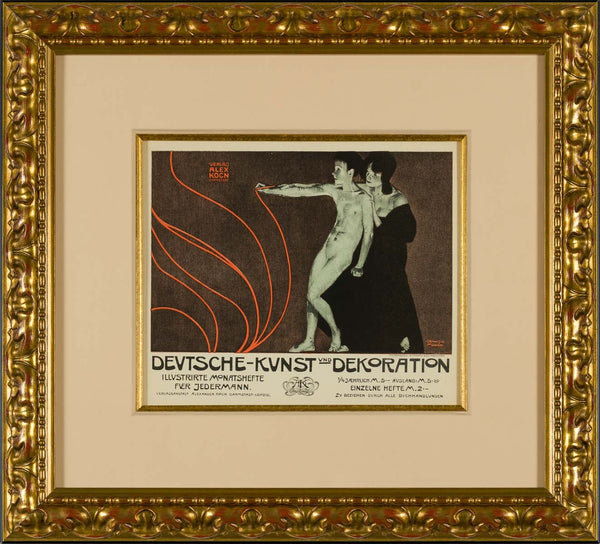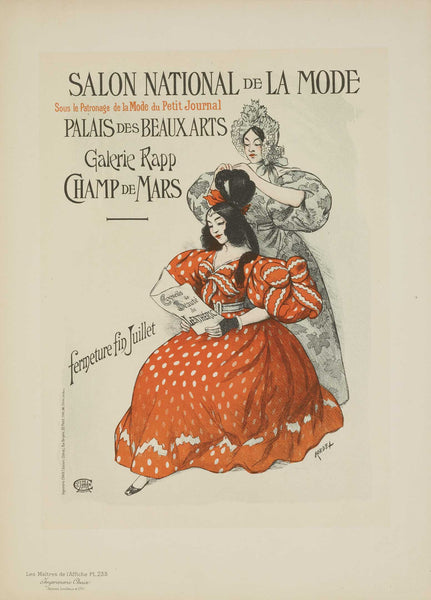Upload a photo of your space
For best results we recommend marking 10 inches on your wall with tape to get a sense of scale. Make sure to have the floor visible in the photo.


About the Work
“Les Maitres De L’Affiche” (The Masters of the Poster) is a phrase that refers to one of the most prestigious and influential art publications in history. The 256 color plates that make up the suite represent a wide-ranging selection of outstanding original posters from the turn of the twentieth century when this popular art form first reached its peak.Early printed posters were very text-heavy, with relatively few illustrations. After all, they were created to advertise products, and adding an illustration to an advertisement in the mid-1800s was not commonplace. However, during the second half of the nineteenth century, when all types of commercial products were aesthetically upgraded, serious artists began to see the new possibilities in the poster medium. By linking their imagery to modern commerce, the thinking was that each would be enhanced by the value of the other.
This was especially true for Jules Cheret (1836-1932) whose unique combination of artistic, technical, and entrepreneurial talents paved the way for an actual poster industry. Cheret opened his own print shop in Paris in 1866 – Imprimerie Chaix – and his work then began to inspire numerous emulators throughout Europe and America.
By the 1890s the streets of every great city were enlivened by large, colorful posters. The posters had not only caught the fancy of the public, but its best examples were already being regarded as true works of art (specifically, as fine prints) to be exhibited, reviewed in journals, and collected and reproduced in a more manageable form. In the last five years of the century, the ebullient spirit of the “Belle Epoque,” gave birth to a new artistic movement. It was during those years that Imprimerie Chaix was to play a significant part in codifying, hallowing, and perpetuating Cheret’s vision through printmaking. The print shop published smaller chromolithographic versions (in authentic colors) of over 200 highly regarded posters from the time. These posters were created by more than 90 great artists, each bringing this fabulous period to life for us today.
The renowned set of 256 posters were created by Imprimerie Chaix, forever to be known as a set as “Les Maitres de La’Affiche.” Each poster was rendered as a separate sheet measuring 11 ¼ x 15 – inches. The set was compiled uniquely. Every month for 60 months – from December 1895 through November 1900 – subscribers received a wrapped parcel containing four consecutively numbered poster reproductions. Each parcel consisted of 16 occasions (each of the five Decembers, the Junes, as well as the March and September months from the final three years of publishing). The monthly wrapper also contained a bonus plate, not a poster reproduction, of a specially created lithograph. The compilations of this set of original posters make up the complete suite known as “Les Maitres De L’affiche.”
“National Academy of Music (Plate 34)” was created by Theophile – Alexandre Steinlen who was born in Lausanne, Switzerland. Steinlen studied at the University of Lausanne before taking a job as a designer trainee at a textile mill in France. In his early 20’s he was still developing his skills as a painter when he and his new wife were encouraged to move to the artistic community in the Montmartre Quarter of Paris. Once there, Steinlen was befriended by the painter Adolphe Willette who introduced him to the artistic crowd at Le Chat Noir that led to his commissions to do poster art for the cabaret owner/entertainer, Aristide Bruant and other commercial enterprises. His 1895 lithograph titled Les Chanteurs des Rues was the frontispiece to work entitled Chansons de Montmartre published by Editions Flammarion with sixteen original lithographs that illustrated the Belle Epoque songs of Paul Delmet. His permanent home, Montmartre and its environs, was a favorite subject throughout Steinlen's life and he often painted scenes of some of the harsher aspects of life in the area. In addition to paintings and drawings most notable figures of cats that he had great affection for as seen in many of his paintings. Today, his works can be found at many museums around the world including at the Hermitage Museum in St. Petersburg, Russia. And the National Gallery of Art in Washington, D.C., United States. “National Academy of Music (Plate 34)” is an 11.35 x 8.75 – inch original stone lithograph.
About the Artist
“Les Maitres De L’Affiche” (The Masters of the Poster) is a phrase that refers to one of the most prestigious and influential art publications in history. The 256 color plates that make up the suite represent a wide-ranging selection of outstanding original posters from the turn of the twentieth century when this popular art form first reached its peak. Early printed posters were very text-heavy, with relatively few illustrations. After all, they were created to advertise products, and adding an illustration to an advertisement in the mid-1800s was not commonplace. However, during the second half of the nineteenth century, when all types of commercial products were aesthetically upgraded, serious artists began to see the new possibilities in the poster medium. By linking their imagery to modern commerce, the thinking was that each would be enhanced by the value of the other.
Please utilize the AR experience in a well-lit room.
Scan the room for surface detection.

Artwork will place in your room.
Using your fingers, align the horizontal white line
with your floor.

Double tap the artwork to scale to 100% size
and pinch to move on the screen.






